Structural Organization in Animals For Free
Free PDF download of NCERT Exemplar for Class 11 Biology Chapter 7 - Structural Organization in Animals solved by expert Biology teachers on Vedantu as per NCERT (CBSE) Book guidelines. All Chapter 7 - Structural Organization in Animals exercise questions with solutions to help you to revise the complete syllabus and score more marks in your examinations.
NCERT Exemplar is a unique textbook by which students can acquire fundamental knowledge on structural organization and the key principles of biology. The book contains NCERT format for both Hindi and English versions. NCERT books are in pdf format which can be read using the popular internet browser like chrome, internet explorer, firefox, safari etc. NCERT Exemplar for Class 11 Biology - Structural Organisation in Animals has been prescribed by the subject expert team members which makes it a one-stop solution for students who want to learn the biological structure from bestseller NCERT books.
Access NCERT Exemplar Solutions for Class 11 Science(Biology) Chapter 7 - Structural Organisation in Animals
Multiple Choice Questions (MCQs)
Which one of the following types of cell is involved in making of the inner walls of blood vessels?
Cuboidal epithelium
Columnar epithelium
Squamous epithelium
Stratified epithelium
Ans: The correct option is (c) Squamous epithelium
Explanation: Squamous epithelium is functioned for making the inner walls of blood vessels. The major role of squamous epithelium is to carry out the diffusion of gases and small molecules.
2. To which one of the following categories does adipose tissue belong?
a. Epithelial
b. Connective
c. Muscular
d. Neural
Ans: The correct option is (c) Connective Tissue
Explanation: Adipose tissue is a type of connective tissue that is composed of fat cells known as adipocytes. The adipocytes contain large fat globules within a fibrous network.
3. Which one of the following is not a connective tissue?
a. Bone
b. Cartilage
c. Blood
d. Muscles
Ans: The correct option is (d) Muscles
Explanation: The function of connective tissues is to connect, bind and provide support to the various parts of the body. Out of the four given options, muscle is not a type of connective tissue. It is because muscles are not involved in providing connection to tissues or body parts; they are there to provide movement to the body.
4. Setae help in locomotion in earthworm but are not uniformly present in all the segments. They are present in
a. 1st segment
b. Last segment
c. Clitellar segment
d. 20th - 22nd segment
Ans: The correct option is (d) 20th - 22nd segment
Explanation: The locomotion in earthworm occurs by contracting their body to move forward with the help of the bristle-like structures called as setae, which are found in the 20th - 22nd segment.
5. Which one of the following statements is true for cockroaches?
a. The number of ovarioles in each ovary are ten.
b. The larval stage is called caterpillar
c. Anal styles are absent in females
d. They are ureotelic
Ans: The correct option is (c) Anal styles are absent in females.
Explanation: The anal styles are paired and thin outgrowths, which project backwards from the sides of 9th sternum only in male cockroaches.
6. Match the following and choose the correct option
Column I | Column II |
A. Adipose tissue | i. Nose |
B. Stratified epithelium | ii. Blood |
C. Hyaline cartilage | iii. Skin |
D. Fluid connective tissue | iv. Fat storage |
(a) A-(i), B-(ii), C-(iii), D-(iv)
(b) A-(iv), B-(iii), C-(i), D-(ii)
(c) A-(iii), B-(i), C-(iv), D-(ii)
(d) A-(ii), B-(i), C-(iv), D-(iii)
Ans: The correct option is (b).
Explanation: Adipose tissue is responsible for storage of fat, stratified epithelium is present in the skin, the cartilage is present in the nose, and the blood is a fluid that connects the tissues.
7. Match the followings and choose the correct option
Column I | Column II |
A. Hermaphrodite | i. Produces blood cells and haemoglobin |
B. Direct Development | ii. Testis and ovary in the same animal |
C. Chemoreceptor | iii. Larval form absent |
D. Blood gland in earthworm | iv. Sense of chemical substances |
Options:
(a) A-(ii), B-(iii), C-(iv), D-(i)
(b) A-(iii), B-(ii), C-(iv), D-(i)
(c) A-(i), B-(iii), C-(ii), D-(i)
(d) A-(ii), B-(iv), C-(iii), D-(i)
Ans: The correct answer is (a).
Explanation: Hermaphrodite is an individual having both the sex organs i.e, ovary and testis present in them. Direct development is a type of development in which the young one directly develops into a mature individual, without going through the larval stage. The chemoreceptors are a type of sensory receptors that detect chemicals. The blood glands in earthworms produce blood cells and haemoglobin.
8. Match the following with reference to cockroach and choose the correct option
Column I | Column II |
A. Phallomere | i. Chain of developing ova |
B. Gonopore | ii. Bundles of sperm |
C. Spermatophore | iii. Opening of the ejaculatory duct |
D. Ovarioles | iv. The external genitalia |
Options:
a. A-iii, B-iv, C-ii, D-i
b. A-iv, B-iii, C-ii, D-i
c. A-iv, B-ii, C-iii, D-i
d. A-ii, B-iv, C-iii, D-i
Ans: The correct option is (b).
Explanation: Phallomere is the external genitalia present in male cockroaches. The opening of the ejaculatory duct is known as gonopore. Spermatophore is a term used to refer to the bundle of sperms. Ovariole is a chain of developing ova and there are 8 ovarioles present in a single ovary.
9. Match the following and choose the correct option
Column I | Column II |
A. Touch | i. Nasal epithelium |
B. Smell | ii. Foramen magnum |
C. Cranial nerves | iii. Sensory papillae |
D. Medulla oblongata | iv. Peripheral nervous system |
Options:
a. A-iii, B-i, C-ii, D-iv
b. A-ii, B-i, C-iv, D-iii
c. A-iii, B-iv, C-ii, D-i
d. A-iii, B-i, C-iv, D-ii
Ans: The correct option is (d).
Explanation: Sensory papillae are touch receptors. The nasal epithelium is present in the nose and is responsible for smell. Cranial nerves are a part of the peripheral nervous system. The Medulla oblongata passes out through foramen magnum.
Very Short Answer Type Questions-:
1. State the number of segments in earthworm which are covered by a prominent dark band or clitellum.
Ans: There are three segments present in earthworm, i.e., 14th, 15th and 16th that are covered by a prominent dark band or clitellum.
2. Where are sclerites present in a cockroach?
Ans: The sclerites are hard chitinous plates present in all the body segments of cockroaches.
3. How many times do nymphs moult to reach the adult form of cockroach?
Ans: The nymph moults about 13 times to reach the adult form of cockroach.
4. Identify the sex of a frog in which sound producing vocal sacs are present.
Ans: The sound producing vocal sacs are present in male frogs.It plays a very important role in the process of mating to attract the female partner.
5. Name the process by which a tadpole develops into an adult frog.
Ans: A tadpole develops into an adult frog by the process of metamorphosis.
6. What is the scientific term given to earthworm’s body segments?
Ans: Earthworms belong to phylum annelida & the scientific term that is given to earthworm’s body segments is metamars.
7. A muscle fibre tapers at both ends and does not show striations. Name the muscle fibre.
Ans: The muscle fiber that are tapers at both the ends and do not show striations are smooth muscle fibers.
8. Name the different cell junctions found in tissues.
Ans: Different cell junctions that are found in tissues are-:
1. Tight junctions-: Here the plasma membrane membrane of adjacent epithelial cells are held close together.
2. Gap junctions-:They are formed for the exchange of chemicals between the adjacent cells.
3. Adhering junctions-: As the name suggests they stick together the neighboring cells.
9. Give two identifying features of an adult male frog.
Ans: The identifying features of an adult male frogs are-:
1. In male frogs vocal cords are present for the sound production that play an important role in attracting the female frog for mating.
2. Presence of copulatory pads on the first digit of the forelimb of male frog.It helps in holding the female frog during amplexus (copulatory position of frog).
10. Which mouth part of a cockroach is comparable to our tongue?
Ans: Hypopharynx in cockroaches is comparable to human tongue.It helps in movement of food in the preoral cavity.
11. The digestive system of frogs is made of the following parts. Arrange them in an order beginning from the mouth.
Mouth, oesophagus, buccal cavity, stomach, intestine, cloaca, rectum, cloacal aperture
Ans: The arrangement of frog’s alimentary canal is-:
Mouth → Buccal cavity → Oesophagus → Stomach → Intestine → Rectum → Cloaca → Cloacal aperture
12. What is the difference between cutaneous and pulmonary respiration?
Ans:
Cutaneous Respiration | Pulmonary Respiration |
1. It is the kind of respiration that involves the exchange of gases via the skin or by the body surface. | 1. It is the kind of respiration that involves the exchange of gases via the alveoli in lungs. |
2.It occurs in amphibians, insects & fishes. | 2. It occurs mainly in mammals. |
13. Special venous connection between liver and intestine and between kidney and intestine is found in frogs, what are they called?
Ans: Special venous connection between liver and intestine is called hepatic portal system & between kidney and intestine is called renal portal system.
Short Answer Type Question
1. Give the location of hepatic caeca in a cockroach. What is their function?
Ans: The word “hepatic'' used for “liver” and hepatic caeca in earthworm performs a function that's analogous to liver in vertebrates. In cockroaches, it is present at the junction of the foregut and midgut. It is a hoop of 6-8 blind tubules. Their function is to secrete digestive juices to facilitate the process of digestion.
2. Frogs are beneficial for mankind, justify the statement.
Ans: The reason why frogs are beneficial for both mankind and environment are as follows:
a) Frogs help in preventing damage to crops as they prey upon many insects and pests.
b) Frogs form an important link in the food chain by becoming the secondary consumers. In this way, frogs form an important component of the ecosystem for maintaining ecological balance.
c) Some parts of frogs, i.e., legs are also eaten by man as they are very muscular.
3. The body of sponges does not possess tissue level of organisation though it is made of thousands of cells. Comment.
Ans: In tissue level of organization, groups of cells work together to perform a specific function. The body of sponges is made of multiple cells, but most of the cells work independent of each other. There is no coordination between the cells and because of the absence of division of labour, sponges do not possess tissue level of organization.
4. Structural organisation in animals attains different levels as a cell - organ - organ system. What is missing in this chain? Mention the significance of such an organisation.
Ans: In the given chain, tissue level of organization is missing. When a group of cells work together to carry out a specific function, they give rise to a tissue. Tissue level is an important organizational level because the division of labour starts at this very level.
5. Stratified epithelial cells have a limited role in secretion. Justify their role in our skin.
Ans: Such type of tissues that are made up of more than one type of epithelial cells.This type of tissues mainly protective in nature against the mechanical & the chemical stress.Hence , they have a limited role in secretion.
6. How does a gap junction facilitate intercellular communication?
Ans: Gap junction facilitates intercellular communication by allowing the small signaling molecules to pass from cell to cell.These are hydrophilic junctions that are made up of two protein cylinders called connexus.The movement of molecules through this channel is controlled by PH & Ca2+ions Concentration.
7. Why are blood, bone and cartilage called connective tissue?
Ans: Blood, bone and cartilage called connective tissue because-:
1. They all are mesodermal in origin.
2. They connect different tissues and organs of the body.
3. They are protective in nature.
8. Why are neurons called excitable cells? Mention special features of the membrane of the neuron?
Ans: Neurons are called excitable cells because they have an electrical potential difference i.e.whenever they are in a polarised state , they quickly stimulate an electrical disturbance. There is a change in the potential difference and depolarisation or impulses are observed from the input to output region of the neuron which passes on to the adjacent neuron. Special features of the membrane of the neuron is the capability of getting polarized or depolarized.
9. Why is the earthworm called the friend of the farmer?
Ans: Earthworms are called the friend of the farmer because of their capability to convert biodegradable waste into organic fertilizer that is very helpful in increasing the soil fertility.
10. How do you distinguish between dorsal and ventral surface of the body of earthworms.
Ans:
Dorsal Surface | Ventral Surface |
1. It is the top most portion of the earthworm. | 1. It is the bottom side of the earthworm. |
2. It is darker in colour. | 2. It is lighter in colour. |
3. Setae are not there. | 3. Setae are there. |
11. Correct the wrong statements among the following:
a. In earthworm, a single male genital pore is present.
Ans: This statement is wrong , There is a pair of male genital pore that is present in the 18th segment of the earthworm.
b. Setae help in locomotion of earthworms.
Ans: This statement is true.
c. Muscular layer in the body wall of earthworm is made up of only circular muscles.
Ans: This statement is wrong because the muscular layer in the body wall of earthworm is made up of an outer layer of circular muscles & inner layer of longitudinal muscles.
d. Typhlosole is the part of the intestine of earthworm.
Ans: This statement is true.
12. Why nephridia in earthworm that are basically similar in structure classified into three types? Mention the names of each.
Ans: Nephridia are found in invertebrates & functions similarly to vertebrate kidneys. They are classified into three types on the basis of their location in the body.
1. Septal nephridia-:This kind of nephridia is present on both sides of the intersegmental septa of segment no.15 to last.
2. Integumentary nephridia-:These are attached to the lining of the body wall of segment no.3 to last.
3. Pharyngeal nephridia-: These are present as tufts in the three pairs in the segment no. 4th , 5th & 6th.
13. Common name of some animals are given in Column A, write their scientific name in Column B.
Column A | Column B |
a. Tiger | _________ |
b. Peacock | _________ |
c. Housefly | _________ |
Ans:
Column A | Column B |
a. Tiger | Panthera tigris |
b. Peacock | Pavo cristatus |
c. Housefly | Musca domestica |
14. Complete the following statement :
a. In cockroach grinding of food particle is performed by ____________
Ans: In cockroaches grinding of food particles is performed by the gizzard.
b. Malpighian tubules help in removal of ___________________________
Ans: Malpighian tubules help in removal of nitrogenous wastes.
c. Hind gut of cockroach is differentiated into ______________________
Ans: Hind gut of cockroach is differentiated into ileum , colon & rectum.
d. In cockroach blood vessels open into spaces called ______________
Ans: In cockroach blood vessels open into spaces called haemocoel.
15. Mention special features of eyes in Cockroaches.
Ans: Special features of eyes in cockroaches are -:
1. Their eyes are located on the dorsal side of the head.
2. They are provided with compound eyes.An eye is composed of thousands of individual photoreceptors units called ommatidia.
3. Together thousands of images are formed of a single object.
4. Sensitivity is more but the resolution is very low.
16. Frog is a poikilotherm, exhibits camouflage and undergoes aestivation and hibernation, how are all these beneficial to it?
Ans: Frog is a poikilotherm that means their body temperature changes according to the environment.
Hibernation & aestivation helps them to bypass the unfavourable environmental conditions.
Camouflage is defined as the ability of an animal to change their body colour according to the surroundings. It helps them to escape from the predators as well as catching their prey.
17. Write the functions in brief in column B, appropriate to the structures given in column A.
Column A | Column B |
a. Nictitating membrane | i. ________ |
b. Tympanum | ii. ________ |
c. Copulatory pad | iii. ________ |
Ans:
Column A | Column B |
a. Nictitating membrane | i. It is helpful underwater vision. |
b. Tympanum | ii. It catches the sound waves |
c. Copulatory pad | iii. It is helpful in holding on the female frog during copulation |
18. Write the appropriate type of tissues in column B according to the functions mentioned in column A.
Column A | Column B |
a. Secretion and absorption | i. ____________________ |
b. Protective covering | ii. ____________________ |
c. Linking and supporting framework | iii. ____________________ |
Ans:
Column A | Column B |
a. Secretion and absorption | i. Simple columnar epithelium. |
b. Protective covering | ii. Stratified epithelium. |
c. Linking and supporting framework | iii. Connective tissue. |
19. Using appropriate examples, differentiate between false and true body
segmentation.
Ans:
True BodySsegmentation | False Body Segmentation |
1. In this kind of segmentation segments are interrelated. | 1. In this kind of segmentation different segments are independent of each other. |
2. Different segments work together in a coordinated manner. | 2.Different segments work in an independent manner. |
3. The example includes-: Earthworm. | 3.The example includes-:Tape-worm. |
20. What is special about tissue present in the heart?
Ans: Special feature of tissues present in heart are-:
1.They are auto excitatory in nature i.e. they are having their own mechanism of contraction.
2. They continuously work throughout life without a pause.
3. They have rich supply of blood.
Long Answer Type Questions-:
1. Classify and describe epithelial tissue on the basis of structural modifications of cells.
Ans: Epithelial tissue is the type of animal tissue in which the cells are densely packed.It acts as the covering & lining of various body surfaces & cavities.On the basis of structural modification of cell these are of three types-:
Squamous Epithelium | Cuboidal Epithelium | Columnar Epithelium |
It is made up of a single layer of flattened cells. The cells in this kind of tissue have irregular boundaries. This type of tissue is found in walls of blood vessels & in air sacs of the lungs. These types of tissues are involved in the process of diffusion. 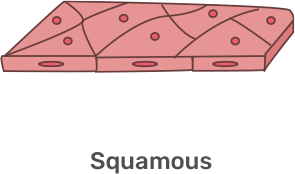
| It is made up of a single layer of cuboidal cells. This type of tissues are found in the ducts of gland & in nephron. Secretion & absorption are the main functions of this kind of tissue. 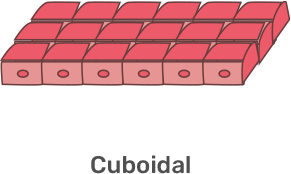
| It is made up of a single layer of tall & slender cells. This type of tissue is found in the lining of the stomach & intestine. Secretion & absorption are the main functions of this kind of tissue. 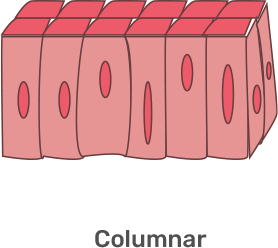
|
2. Write down the common features of the connective tissue. On the basis of structure and function, differentiate between bones and cartilages.
Ans: Common feature of connective tissue are-:
1. These kind of tissues provide the structural framework to the body.
2. They connect the different parts of the body.
3. These type of tissues are mesodermal in origin.
Bone | Cartilage |
1.The intercellular material is hard & non-pliable. | 1. The intercellular material is solid & pliable. |
2.Bone cells are called osteocytes. | 2.Cartilage cells are called chondrocytes. |
3. In bones blood vessels are there. | 3.In cartilage blood vessels are not there(nutrients are obtained by the process of diffusion). |
4. Haversian canal is present. | 4. Haversian canal is absent. |
3. Comment upon the gametic exchange in earthworm during mating.
Ans: The mating process in earthworms is called copulation which occurs during the rainy season. The steps that are involved in gamete exchange in the earthworms are given below-:
i) Two earthworms come closer to each other and get ventrally attached to each other in opposite directions.
ii) The copulation process begins when the male genital pore (i.e., papilla) of one earthworm is inserted into the spermathecal pore of the another earthworm.
iii) The earthworm remains mutually approximate by the penetration of setae in their bodies.
iv)Sperm and prostatic fluid of the earthworm are exchanged and the spermathecal pore stores the spermatozoa.
v) The earthworms remain attached for an hour and the sperm and egg are passed into a cocoon which gets secreted by the clitellar gland present in the 14th to the 16th segment of the earthworm.
4. Explain the digestive system of Cockroach with the help of a labelled sketch.
Ans: The alimentary canal of cockroaches is divided into two three parts that are -: Foregut , Midgut & Hindgut.
1. Foregut-: It consists of pharynx ,oesophagus , crop & gizzard
Pharynx-: It is the short structure that opens into the oesophagus.
Oesophagus-: It is the narrow tubular structure where pharynx opens.
Crop-: It is the pouch-like structure in which the oesophagus opens. Here food is stored for some-time.
Gizzard-: Crop is open here.It is helpful in grinding of food particles.
2. Hepatic caeca-: It is present between the foregut & midgut.It is similar in functioning of the liver.It plays a very important role in the process of digestion by secreting digestive enzymes.
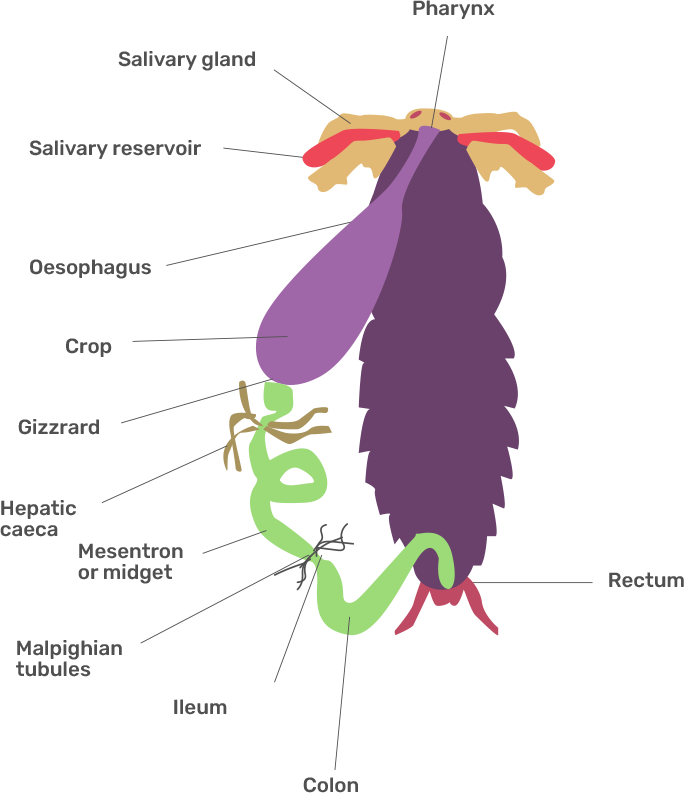
3. Midgut-: The process of digestion occurs here.
4. Malpighian Tubules-: These are present between the midgut & the hindgut.These are the main excretory organ in cockroaches that removes the nitrogenous waste out of the body.
5. Hindgut-: It is divided into ileum , colon & rectum.
5. Draw a neat and well labelled diagram of male reproductive system of a frog.
Ans: The well labelled diagram of frog is given below-:
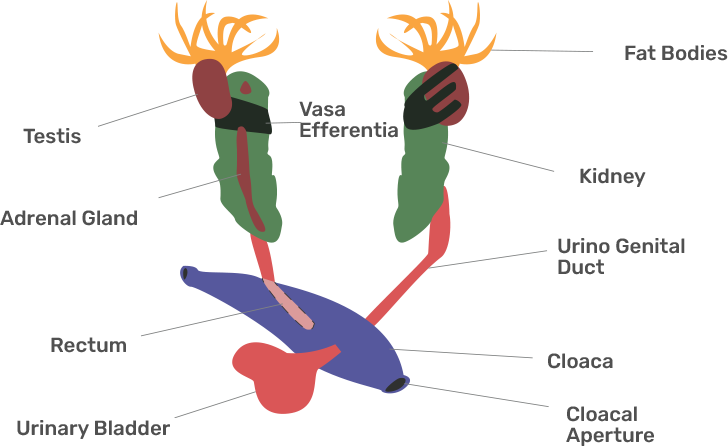
Chapters in Structural Organization in Animals
Biology was earlier a subject of research but now this subject has also become one of the sciences at par with other science subjects. When it comes to Biology, there are a variety of topics that can be covered in detail. These include,
Microbiology
Biology
Cellular Biology
Genetics
Bioinformatics
Structural Bioinformatics
NCERT Biology Exemplar Class 11 Solutions is a compilation of all types of Science problems for class 11 students. The entire book is compiled to cover all the topics and solve the problems in the most effective manner. All the Biology Exemplar Problems are designed by the leading authors of NCERT and are in keeping with the highest standards of the syllabus. This book not only serves as an interactive study material but will also allow you to test your learning by challenging problems that can be tested on many levels. The content of this book is comprehensive and you will find a lot of information. The book is an absolute must-have for all those who need to prepare for class 11 as well as IB Biology Students. This Biology Exemplar book can be a good companion to Biology books.
It is highly recommended to read the chapter in-depth and practice the question given below it. We encourage you to use this chapter regularly for your class 11 school and college exam preparation.
The structure of animals is made of various tissues, which form functional units called organs. Each organ carries out a specific function in the body and its structure is determined by the type of tissue and how it grows. The major organs include the heart, lungs, kidneys, liver, stomach, intestine, spleen, and others. A body without organs is not possible, and hence their shape and size vary in different animals. This book describes the internal and external structures of different animals.
In each of these major organs, specialized cells called various tissues and specialized tissue types have been evolved to perform specific functions. Organ development has been influenced by environmental factors, evolution, inheritance and epigenetic factors.
Each of these major organs has a function to serve, and hence we need to understand the function of the organ. However, before we discuss the major organs in this book, we will first discuss the structure of cells, organelles, and the genetic content of cells. After discussing the important aspects, the main text would have separate chapters on the heart, lungs, kidney, liver, stomach, intestine, spleen and other organs. The chapter on organs will have a description of the internal and external structure of different types of animals, their size and shape, along their functions.
Here is the List of Chapters:
Chapter 1 The Living World
Chapter 2 Biological Classification
Chapter 3 Plant Kingdom
Chapter 4 Animal Kingdom
Chapter 5 Morphology of Flowering Plants
Chapter 6 Anatomy of Flowering Plants
Chapter 7 Structural Organization in Animals
Chapter 8 Cell The Unit Of Life
Chapter 9 Biomolecules
Chapter 10 Cell Cycle and Cell Division
Chapter 11 Transport in Plants
Chapter 12 Mineral Nutrition
Chapter 13 Photosynthesis in Higher Plants
Chapter 14 Respiration in Plants
Chapter 15 Plant Growth and Development
Chapter 16 Digestion and Absorption
Chapter 17 Breathing and Exchange of Gasses
Chapter 18 Body Fluids and Circulation
Chapter 19 Excretory Products and their Elimination
Chapter 20 Locomotion and Movement
Chapter 21 Neural Control and Coordination
Chapter 22 Chemical Coordination and Integration
FAQs on NCERT Exemplar for Class 11 Biology - Structural Organization in Animals - Free PDF Download
1. What is the structural organization of cells and organs?
The structural organization of cells is how they are arranged to form tissues and organs. The structural organization of organs is how organs are arranged to form the body and organs. The structural organization of living beings is the way in which cells and organs are arranged to form tissues, organs, organs of organs, and the body. The structural organization of animals is how cells and organs are arranged to form the body.
2. What is the morphogenetic series?
The morphogenetic series is the evolutionary order of life forms. In short, morphogenetic series is the evolutionary process. It shows the evolutionary relationships between species. The evolution sequence is from unicellular organisms to multicellular organisms. The unicellular organism is the simplest organism such as bacteria, archaea, and protozoa. The unicellular organism is the first complex living being. Unicellular organisms make their energy and nutrients by photosynthesis and chemosynthesis. The unicellular organism evolves by morphogenetic series. The morphogenetic series is based on a series of small changes leading to evolutionary changes.
3. What is phylogeny?
Phylogeny is a term used for evolutionary relationships. Phylogeny is based on the evolutionary relationships between organisms. It describes the evolutionary process from unicellular organisms to multicellular organisms. The phylogenetic research is based on DNA and morphology. The phylogeny explains the relationship between species. It traces the evolutionary processes of living beings. The phylogeny is usually explained by the cladogram.
4. What is the development?
It is the developmental process in which a new, differentiated and specialized cell is formed. The development of an organism or embryonic development is the study of the morphogenetic process. Developmental biology, the study of developmental processes, is embryology. The developmental processes include cellular differentiation, proliferation, cell cycle, growth and death. Developmental processes in an organism are very complex. Developmental processes involve the development of the nervous system, immune system, bone structure and other anatomical structures. Developmental processes affect human reproduction and the birth of new offspring.
5. Where can I download NCERT Exemplar for Class 11 Biology - Structural Organization in Animals?
Vedantu is dedicated to providing students with the best resources possible. We have made NCERT Exemplar for Class 11 Biology - Structural Organization in Animals available for download. It comes in different formats accommodating to the feasibility of the user. You can access it anywhere, anytime on the browser or the app - the choice is yours.

























